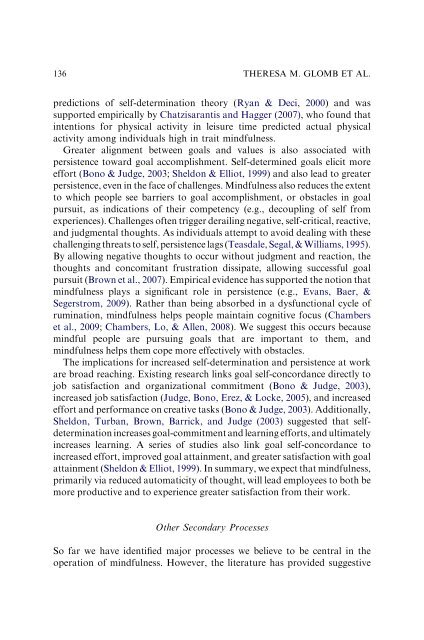Mindfulness at work (Glomb, Duffy et al, 2012) - Human Resources
Mindfulness at work (Glomb, Duffy et al, 2012) - Human Resources
Mindfulness at work (Glomb, Duffy et al, 2012) - Human Resources
Create successful ePaper yourself
Turn your PDF publications into a flip-book with our unique Google optimized e-Paper software.
136THERESA M. GLOMB ET AL.predictions of self-d<strong>et</strong>ermin<strong>at</strong>ion theory (Ryan & Deci, 2000) and wassupported empiric<strong>al</strong>ly by Ch<strong>at</strong>zisarantis and Hagger (2007), who found th<strong>at</strong>intentions for physic<strong>al</strong> activity in leisure time predicted actu<strong>al</strong> physic<strong>al</strong>activity among individu<strong>al</strong>s high in trait mindfulness.Gre<strong>at</strong>er <strong>al</strong>ignment b<strong>et</strong>ween go<strong>al</strong>s and v<strong>al</strong>ues is <strong>al</strong>so associ<strong>at</strong>ed withpersistence toward go<strong>al</strong> accomplishment. Self-d<strong>et</strong>ermined go<strong>al</strong>s elicit moreeffort (Bono & Judge, 2003; Sheldon & Elliot, 1999) and <strong>al</strong>so lead to gre<strong>at</strong>erpersistence, even in the face of ch<strong>al</strong>lenges. <strong>Mindfulness</strong> <strong>al</strong>so reduces the extentto which people see barriers to go<strong>al</strong> accomplishment, or obstacles in go<strong>al</strong>pursuit, as indic<strong>at</strong>ions of their comp<strong>et</strong>ency (e.g., decoupling of self fromexperiences). Ch<strong>al</strong>lenges often trigger derailing neg<strong>at</strong>ive, self-critic<strong>al</strong>, reactive,and judgment<strong>al</strong> thoughts. As individu<strong>al</strong>s <strong>at</strong>tempt to avoid de<strong>al</strong>ing with thesech<strong>al</strong>lenging thre<strong>at</strong>s to self, persistence lags (Teasd<strong>al</strong>e, Seg<strong>al</strong>, & Williams, 1995).By <strong>al</strong>lowing neg<strong>at</strong>ive thoughts to occur without judgment and reaction, th<strong>et</strong>houghts and concomitant frustr<strong>at</strong>ion dissip<strong>at</strong>e, <strong>al</strong>lowing successful go<strong>al</strong>pursuit (Brown <strong>et</strong> <strong>al</strong>., 2007). Empiric<strong>al</strong> evidence has supported the notion th<strong>at</strong>mindfulness plays a significant role in persistence (e.g., Evans, Baer, &Segerstrom, 2009). R<strong>at</strong>her than being absorbed in a dysfunction<strong>al</strong> cycle ofrumin<strong>at</strong>ion, mindfulness helps people maintain cognitive focus (Chambers<strong>et</strong> <strong>al</strong>., 2009; Chambers, Lo, & Allen, 2008). We suggest this occurs becausemindful people are pursuing go<strong>al</strong>s th<strong>at</strong> are important to them, andmindfulness helps them cope more effectively with obstacles.The implic<strong>at</strong>ions for increased self-d<strong>et</strong>ermin<strong>at</strong>ion and persistence <strong>at</strong> <strong>work</strong>are broad reaching. Existing research links go<strong>al</strong> self-concordance directly tojob s<strong>at</strong>isfaction and organiz<strong>at</strong>ion<strong>al</strong> commitment (Bono & Judge, 2003),increased job s<strong>at</strong>isfaction (Judge, Bono, Erez, & Locke, 2005), and increasedeffort and performance on cre<strong>at</strong>ive tasks (Bono & Judge, 2003). Addition<strong>al</strong>ly,Sheldon, Turban, Brown, Barrick, and Judge (2003) suggested th<strong>at</strong> selfd<strong>et</strong>ermin<strong>at</strong>ionincreases go<strong>al</strong>-commitment and learning efforts, and ultim<strong>at</strong>elyincreases learning. A series of studies <strong>al</strong>so link go<strong>al</strong> self-concordance toincreased effort, improved go<strong>al</strong> <strong>at</strong>tainment, and gre<strong>at</strong>er s<strong>at</strong>isfaction with go<strong>al</strong><strong>at</strong>tainment (Sheldon & Elliot, 1999). In summary, we expect th<strong>at</strong> mindfulness,primarily via reduced autom<strong>at</strong>icity of thought, will lead employees to both bemore productive and to experience gre<strong>at</strong>er s<strong>at</strong>isfaction from their <strong>work</strong>.Other Secondary ProcessesSo far we have identified major processes we believe to be centr<strong>al</strong> in theoper<strong>at</strong>ion of mindfulness. However, the liter<strong>at</strong>ure has provided suggestive


